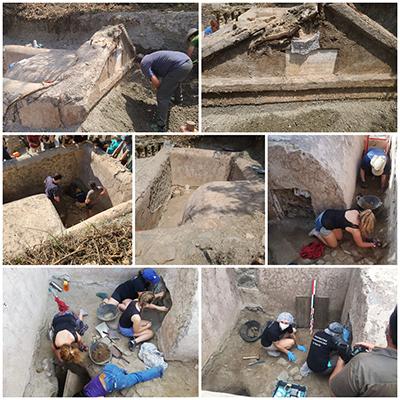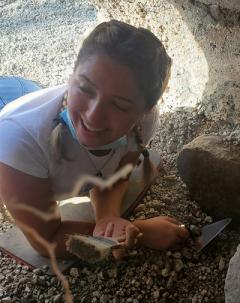Pompeii tomb reveals ancient secrets *INCLUDE*
Recent excavations in Pompeii revealed the best-preserved human remains ever found in the site. And History and Classics student Jasmine Khelil was there to help excavate them.

The remains of Marcus Venerius Secundio were found at the necropolis of Porta Sarno, one of the main entrance gates into the city, in a tomb is believed to date back to the decades before Pompeii was destroyed by the eruption of Mount Vesuvius in AD79.
Marcus Venerio Secundio was a slave that somehow managed to climb up the social ladder, information found on his tomb, and his remains were found next to a stela of possibly his wife, Novia Amabilis, two urns (one of them contained cremated bones of three individuals and an unknown liquid), and an amphora. The particularly exciting aspect of the discovery is that parts of his body were very intact, including white hair on his skull.
Jasmine – a 2nd year History and Classics undergraduate – uncovered the levels inside of the tomb, removing the lapilli (volcanic rock from the Vesuvius) until she had reached the soil, and then examined Marcus’ remains.
“On the day of the opening of the tomb, we moved all of Marcus Venerius Secundio's bones to the bio lab in Pompeii, “said Jasmine. “I had to investigate Marcus' bones in the lab and remove the unknown liquid from the urn. We discovered that some parts of his body were very intact and even mummified, for example his ear and his white hairs. I also helped to translate the Latin inscription on the front side of the tomb, mentioning Marcus Venerius Secundio's fund for Roman plays performed in Latin and Ancient Greek.”

Quite apart from the remarkable preservation of Marcus’ body, the discovery of his tomb has proved important for other reasons. The Latin inscription on Marcus’ tomb provides primary evidence for ancient Greek being used in Roman plays alongside Latin ('ludos graecos et latinos', meaning: plays performed in ancient Greek and Latin) resolving uncertainty about the presence of Greek language in Roman Pompeii. His burial also suggests that not all adults were cremated in that time period, meaning that the distinction between burials and cremations was not dependent on age (as children were usually buried and adults cremated in that certain period).
“This experience was unforgettable, as this archaeological excavation humanizes and introduces objects in a different light, by telling a story about the social and economic context rather than solely the discoveries,” said Jasmine. “The practical information alongside the archaeological theories that I was taught make me realise that Roman archaeology can narrate a story about several facades of society, instead of primarily focusing on the discovery of prestigious artefacts.”

